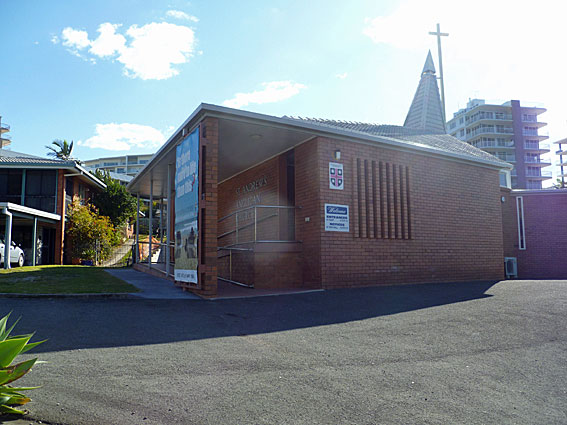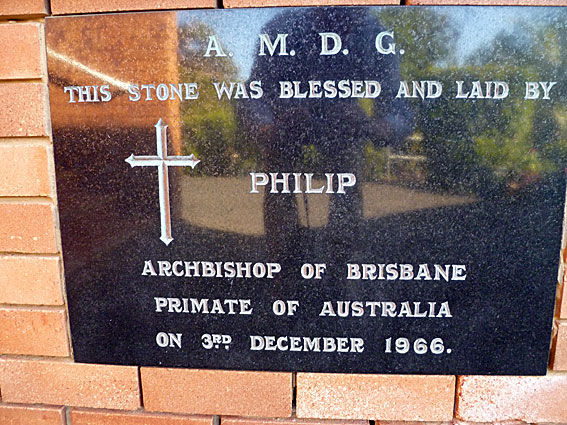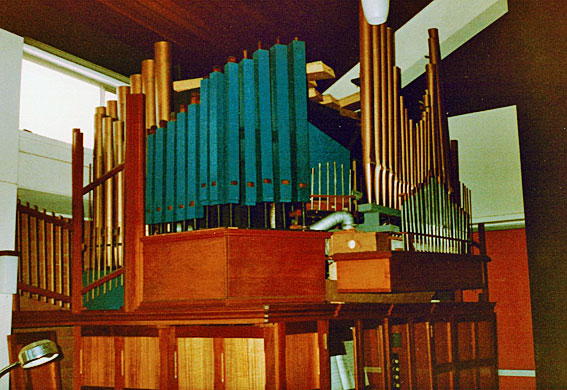
St Andrew's Anglican Church, Caloundra
[Photograph by David Vann (August 2012)]

St Andrew's Anglican Church, Caloundra
[Photograph by David Vann (August 2012)]
Historical and Technical Documentation by Geoffrey Cox
© OHTA 2012, 2015 (last updated June 2015)
The seaside resort of Caloundra marks the southern end of Queensland's Sunshine Coast, which lies to the north of Brisbane. The present St Andrew's Church was built in 1967, replacing an earlier building dating from 1939.1

Foundation stone of the present St Andrew's Anglican Church, Caloundra
[Photograph by David Vann (August 2012)]
An organ was built for the new church in 1967 by Fr John Hamer-Howorth (1913-1988), an Anglican priest who had retired in Toowoomba. Formerly a stained-glass artist in England for twenty years, he had worked for a year as a draftsman at Henry Willis & Sons, London.2 This was the first of three single-manual tracker-action instruments built by Hamer-Howorth in Queensland, the others being at St Alban's Anglican Church, Auchenflower (1972) and St David's Presbyterian Church, Toowoomba (1977). He had previously attempted to rebuild the organ at St Paul's Anglican Church, East Brisbane in 1953-54.

The Hamer-Howorth organ at St Andrew's Anglican Church, Caloundra
[Photograph by David Molloy (early 1980s)]
Typical of Hamer-Howorth's work, the Caloundra instrument was built using second-hand pipework, with divided stops (bass & treble) on a single manual. Most of the pipework was enclosed. He made further additions to the instrument in 1969 and 1973.3
The organ originally had no pedals, and had to be raised four inches for the addition of a pedalboard (of silver ash and blackbean) in 1969. The action was mechanical, but a pneumatic chest was completed for the Open Diapason stop which was added in 1973 and cantilevered out from the front.4
At the time of the addition of the Open Diapason in 1973, all of the stops were described as comprising 56 pipes,5 although the manual compass was noted as comprising 61 notes in 1974. It is possible that some or all of the manual stops extended only to Tenor C, as was the case in other organs by Hamer-Howorth. The Open Diapason was also described in 1973 as comprising 56 pipes, although it was apparently available only on the pedals:
| MANUAL (enclosed) Violin Diapason (Treble) Violin Diapason (Bass) Claribel Flute (Treble) Claribel Flute (Bass) Salicet (Treble) Salicet (Bass) Fifteenth (Treble) Fifteenth (Bass) [Two spare stopknobs] PEDAL Bourdon [Open] Diapason COUPLERS Manual to Pedals [Manual] Octave [Pedal] Octave |
8 8 8 8 4 4 2 2 16 8 |
[1969] [1973] [not operable] |
Tracker action (& tubular-pneumatic)
Compass: 61/30.6
The organ was broken up and removed in 1987 by H.W. Jarrott of Brisbane.7
____________________________________________________________________
1 Glenda Murrell, Anglican Records and Archive Centre Guide to Records (DioceseofBrisbaneWeb, 2001) - cited January 2004.
2 Personal communication to G. Cox from John Hamer-Howorth, December 1972.
3 Dates supplied by Rev. R.E. Mills (Rector), May 1974.
4 Personal communication, Fr John Hamer-Howorth to Geoffery Cox, December 1972.
5 Order of service for Blessing of the Newly-Extended Organ, 30 November 1973.
6 Specification noted by G. Cox, 1974.
7 Date supplied by H.W. Jarrott, c.1990.